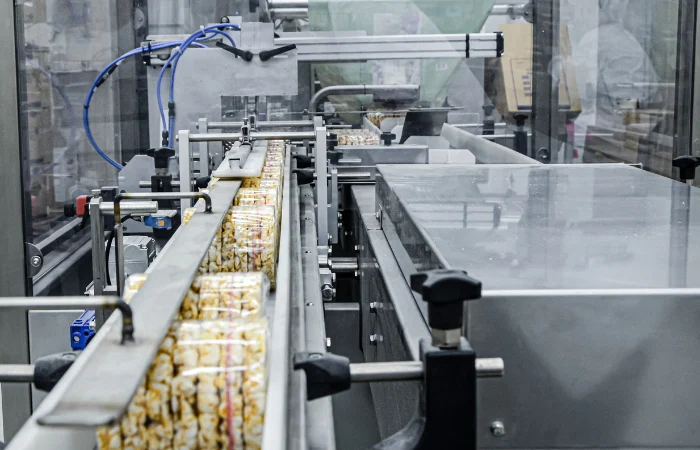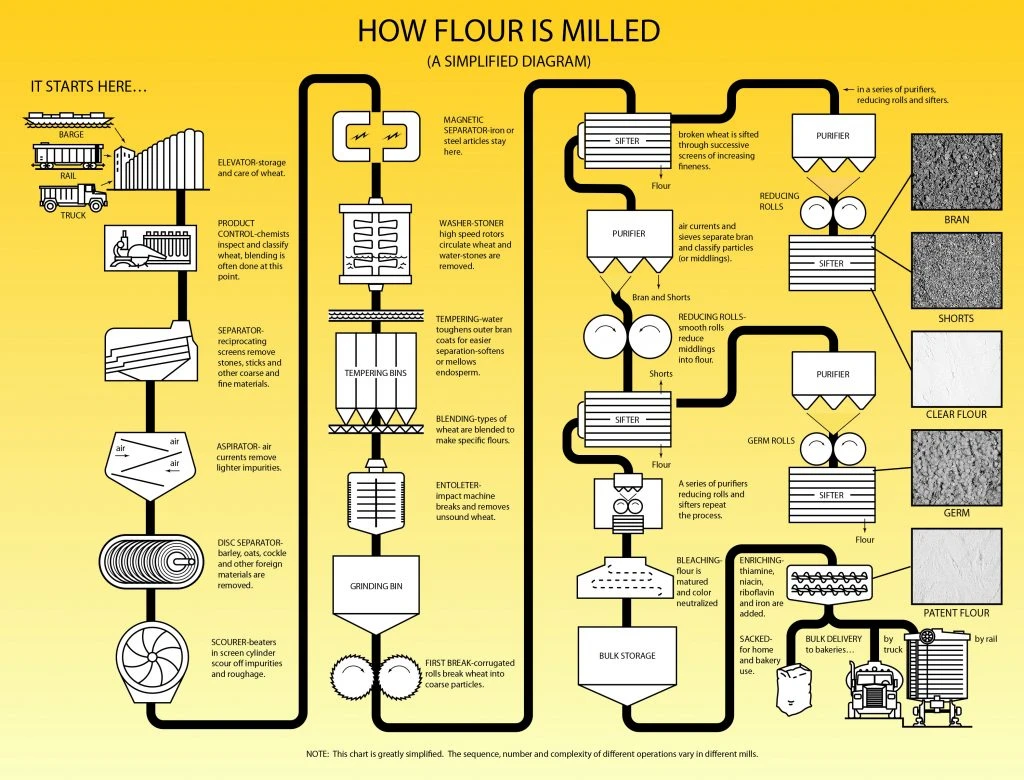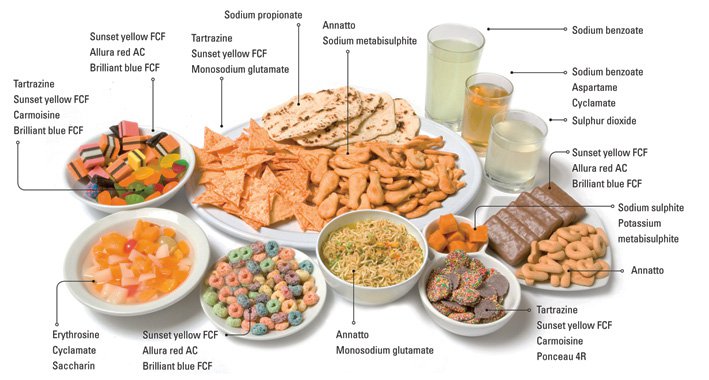In the Western diet, the prevalence of refined or heavily processed foods is a significant concern. These items, often staples in our daily diet, have undergone extensive processing, stripping away vital nutrients like fiber, iron, and B vitamins. This article delves into the complexities of food processing, its evolution, and its profound impact on our health and nutrition.
From Whole Grain to White Flour: A Tale of Nutritional Transformation
When we consider the impact of food processing, the transformation of wheat into white flour offers a stark example of how nutritional values can be altered. This journey highlights the significant changes a food undergoes from its natural state to a heavily processed form.
The Natural State: Whole Wheat
In its natural state, whole wheat is a nutritional powerhouse. It contains all parts of the grain: the bran, germ, and endosperm. This composition provides a rich source of dietary fiber, essential B vitamins (like B1, B2, B3, and B6), minerals (including iron, magnesium, and selenium), protein, and healthy fats.
Whole wheat is known for its benefits in promoting digestive health, regulating blood sugar levels, and reducing the risk of chronic diseases such as heart disease and type 2 diabetes. The fiber in whole wheat also contributes to a feeling of fullness, aiding in weight management.
Industrial Processing: Creating White Flour
The transformation from whole wheat to white flour involves several industrial processes:
- Cleaning and Conditioning: The harvested wheat is cleaned to remove impurities. It’s then conditioned with moisture to toughen the bran and mellow the endosperm, preparing it for milling.
- Milling: The wheat is milled, where the grain is ground and sifted. During this process, the bran and germ are removed, leaving only the endosperm. This is what creates white flour.
- Bleaching and Enriching: Often, the flour is bleached to improve its color and texture. Chemical agents like benzoyl peroxide or chlorine gas are used for this purpose. After bleaching, some manufacturers enrich the flour by adding back certain nutrients like iron and B vitamins, which doesn’t compensate for the full spectrum of nutrients lost.
Nutritional Differences Post-Processing
The transition from whole wheat to white flour results in significant nutritional differences:
- Fiber Loss: Almost all dietary fiber is lost when the bran is removed. Fiber is crucial for digestive health and regulating blood sugar.
- Vitamin and Mineral Reduction: The removal of the germ and bran also strips away most B vitamins and minerals.
- Protein Quality: While the protein content doesn’t change drastically, the quality of protein can be affected due to the loss of complementary nutrients found in the bran and germ.
- Glycemic Index Increase: White flour has a higher glycemic index compared to whole wheat, meaning it can cause a quicker spike in blood sugar levels.
This transformation from a nutrient-rich whole grain to a nutrient-depleted processed flour exemplifies the broader implications of industrial food processing. White flour, devoid of many nutrients found in whole wheat, often serves as the base for many processed foods like bread, cakes, and pastries. Regular consumption of these foods can contribute to nutritional deficiencies and increase the risk of chronic diseases.
Nutritional Impact of Modern Food Processing
Industrial processing often involves removing the outer layers of grains, leading to a significant loss of nutrients. For instance, refining wheat to produce white flour results in a loss of about 70% of its B vitamins, 80% of iron, and almost all the dietary fiber. Scientific studies have consistently shown a reduction in the nutritional value of foods like bread, cereals, and canned goods due to such processing techniques.
But we all learn best from relatable examples, so here you go…
4 Examples To Demonstrate (and Prove) the Nutritional Impact of Modern Food Processing
The process of transforming raw ingredients into processed foods often leads to significant changes in their nutritional content. Here are some real-world examples:
- Fruit Juices vs. Whole Fruits:
- Nutritional Loss: Juicing fruits removes dietary fiber, an essential component found in the skin and pulp. For instance, an apple contains about 4.4 grams of fiber, while a glass of apple juice contains virtually none.
- Sugar Concentration: Juicing also concentrates the sugars while reducing the overall nutrient density. A glass of orange juice can contain the sugars of several oranges without the satiating fiber, leading to higher calorie consumption.
- Canned Vegetables vs. Fresh Vegetables:
- Vitamin Loss: Canning vegetables involves high heat, which can degrade heat-sensitive nutrients like vitamin C and B vitamins. For example, canned peas have about 15-20% less vitamin C than fresh peas.
- Added Sodium: Canned vegetables often contain added salt for preservation, increasing sodium intake, which can affect blood pressure and heart health.
- White Bread vs. Whole Grain Bread:
- Fiber and Nutrient Reduction: As seen with white flour, white bread lacks the fiber, vitamins, and minerals found in whole grain bread. The refining process strips away beneficial components, leading to a product with reduced nutritional value.
- Breakfast Cereals vs. Whole Grains:
- Sugar Addition: Many breakfast cereals, even those marketed as healthy, contain added sugars and preservatives, reducing their overall nutritional quality compared to whole grains like oats or barley.
- Processing Techniques: Extrusion, a common processing technique for cereals, can alter the structure of proteins and potentially reduce the bioavailability of some nutrients.
These examples demonstrate how processing can alter foods’ natural nutrient profile. While they may become more palatable or have a longer shelf life, their diminished nutritional quality can have a significant impact on diet and overall health. In short, you must eat much more to get far less of the nutritional and overall health benefits and in some cases, the foods don’t have the micronutrients and benefits after they’re processed, meaning you’ll never get them!
Health Implications of Processed Foods: Understanding the Risks
The consumption of heavily processed foods is linked to various health issues. Research published in journals like ‘The BMJ’ and ‘Nutrients’ has established connections between processed food consumption and increased risks of obesity, cardiovascular diseases, and type 2 diabetes. These health risks are often attributed to high levels of added sugars, salts, and unhealthy fats in processed foods.
We put together a quick list of valuable scientifically supported findings to help guide you:
- Obesity and Weight Gain
- Studies have shown that diets high in processed foods, like fast food and sugary snacks, are linked to obesity. These foods are often high in calories but low in nutrients and satiety-inducing components.
- A study published in ‘BMJ’ found that higher consumption of ultra-processed foods was associated with higher risks of obesity.
- Heart Disease
- Processed meats such as sausages and deli meats are high in saturated fats and sodium, which are risk factors for heart disease.
- Research in the ‘Journal of the American College of Cardiology’ has shown a correlation between processed meat consumption and an increased risk of coronary heart disease.
- Type 2 Diabetes
- High consumption of refined carbohydrates, like those in white bread and sugary beverages, can lead to spikes in blood sugar and insulin resistance, precursors to type 2 diabetes.
- A study in ‘Diabetes Care’ indicated that a diet high in processed foods, particularly those with added sugars and refined grains, was linked to a higher risk of developing type 2 diabetes.
- Nutrient Deficiencies
- Processed foods are often lacking in essential nutrients like fiber, vitamins, and minerals, leading to potential deficiencies despite high calorie intake.
- An analysis in ‘Public Health Nutrition’ found that high consumption of processed foods can lead to inadequate intake of essential nutrients, contributing to nutritional deficiencies.
Industrial Processing Techniques and Their Nutritional Consequences
Techniques like ultra-high temperature processing, hydrogenation, and the use of artificial additives have become commonplace in industrial food processing. While these methods extend shelf life and enhance taste, they often degrade the nutritional quality of the food. For example, hydrogenation, used to solidify fats, can create trans fats known to be harmful to heart health.
Let’s dig into each of the three most widely used processes that food manufactures are currently dependent on. While the processes are complex, we’ve done our best to simplify each one down to a few important points.
Health Implications of Processed Foods: Understanding the Risks
Ultra-High Temperature (UHT) Processing
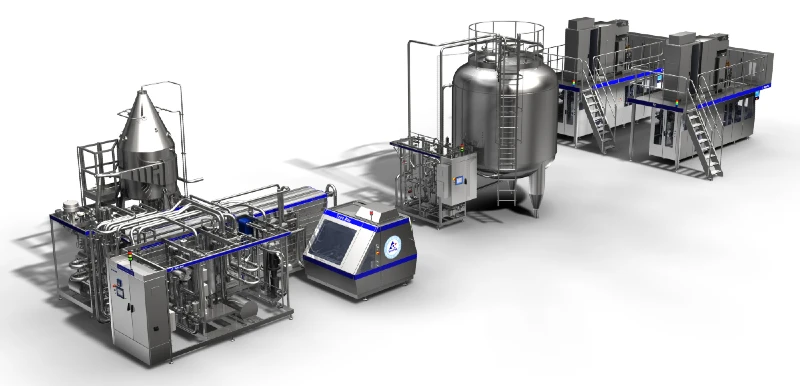
- What It Does: UHT processing involves heating food, typically liquids like milk or juice, to very high temperatures (around 135-150°C or 275-302°F) for a few seconds and then rapidly cooling it.
- How and Why It’s Used: This technique is used to kill harmful bacteria and extend shelf life without the need for refrigeration. It allows products to remain unspoiled for months.
- Nutritional Impact: The high heat degrades heat-sensitive nutrients like vitamins B and C. It also changes the taste and can reduce the natural flavor of the product.
- History: UHT processing was commercially used first in the 1960s, revolutionizing milk preservation and transportation.
Hydrogenation
- What It Does: Hydrogenation involves adding hydrogen to liquid vegetable oils, turning them into solid or semi-solid fats (like margarine).
- How and Why It’s Used: This process is used to increase the product’s stability, texture, and shelf life. It’s common in the production of processed foods like baked goods and snack foods.
- Nutritional Impact: Hydrogenation can create trans fats, which have been linked to increased risk of heart disease, as they raise bad cholesterol (LDL) and lower good cholesterol (HDL).
- History: The process gained commercial popularity in the early 20th century, with brands like Crisco popularizing hydrogenated fats.
Use of Artificial Additives
- What They Do: Additives include a range of substances like colorants, flavor enhancers, preservatives, and stabilizers.
- How and Why They’re Used: They’re used to improve the appearance, taste, and texture of foods, as well as extend shelf life. For instance, preservatives prevent spoilage from bacteria, molds, and yeast.
- Nutritional Impact: Some additives have been linked to health concerns like allergic reactions and other side effects. Preservatives like nitrates and nitrites in processed meats are associated with an increased risk of cancer.
- History: The widespread use of artificial additives accelerated in the mid-20th century with the growth of the processed food industry. Brands like Kraft and General Foods were pioneers in using additives to enhance the appeal of their products.
These industrial processing techniques, while beneficial for extending shelf life and enhancing the sensory appeal of foods, often come at the cost of reduced nutritional quality and potential health risks. Understanding these methods helps consumers make informed decisions about the foods they choose and their potential impact on health and nutrition.
Home Cooking vs. Corporate Processing
Homemade meals typically contain fewer additives and are fresher, retaining more nutrients compared to their processed counterparts.
In contrast, foods produced by large corporations are often calorie-rich but nutrient-poor. These products usually start with low-cost ingredients and are heavily processed with additives like salt, sugar, and fats to enhance palatability. But let’s compare, shall we?
Freshness and Nutrient Retention
- Home Cooking: Preparing meals at home typically involves fresh ingredients, which are more likely to retain their nutritional value. For example, a study in the ‘Journal of Agricultural and Food Chemistry’ found that home cooking preserves antioxidants and vitamins better than industrial processes.
- Corporate Processing: Processed foods often undergo treatments like high-heat processing, which can degrade, and even destroy heat-sensitive nutrients like vitamins C and B.
Ingredient Quality and Additives
- Home Cooking: Home cooks have control over the ingredients, allowing for healthier choices like using whole grains instead of refined ones, fresh produce, and reducing additives and high levels of salt and sugar.
- Corporate Processing: Processed foods often contain additives for preservation, flavor enhancement, and textural improvements. A study from the ‘British Medical Journal’ linked high consumption of processed foods to an increased risk of heart disease and stroke, partly attributed to additives and high sodium content.
Overall Health Impact
- Home Cooking: Regularly eating home-cooked meals has been associated with a healthier diet and reduced risk of obesity, as per a study in ‘Public Health Nutrition.’ This is likely due to better portion control and lower calorie density.
- Corporate Processing: Many processed foods are engineered for hyper-palatability, which can lead to overeating. A study in ‘Cell Metabolism’ found that individuals consuming a diet high in processed foods ate more calories and gained more weight compared to those eating a minimally processed diet.
Nutrient Density and Smart Eating
Nutrient density refers to the amount of nutrients a food contains in relation to the number of calories it provides. Foods like fruits, vegetables, whole grains, and lean proteins are considered nutrient-dense. In contrast, many processed foods are high in calories but low in essential nutrients, contributing to a form of malnutrition despite high calorie intake.
Nutrient density refers to the concentration of essential nutrients in each amount of food. The higher the nutrient content relative to the calorie content, the more nutrient-dense the food is.
But don’t take our word for it, we have the data to back it up, well, technically the Centers for Disease Control and Prevention (CDC) has the data. The CDC developed the Nutrient Density Score, which ranks foods based on their nutrient content. For example, leafy greens score high on this scale due to their rich content in vitamins, minerals, and fiber with relatively few calories.
High Calorie, Low Nutrients
Processed foods, although calorie-dense, often lack essential nutrients. The ‘American Journal of Clinical Nutrition’ found that higher intake of processed foods is associated with lower overall dietary quality. This imbalance can contribute to malnutrition, obesity, and chronic diseases, despite high calorie intake, as per the findings.
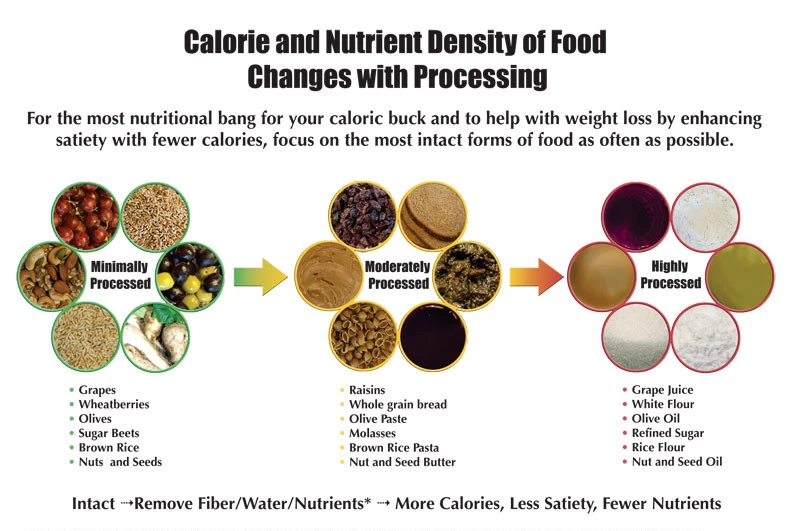
Let’s Get Into The Economic Aspects of Your Food Choices
While processed foods may seem like a more affordable source of calories, they don’t provide the best value in terms of nutrition. A study published in the ‘Journal of the American Dietetic Association’ suggests that when the cost of food is calculated based on nutrient content, healthier options like fruits, vegetables, and lean meats offer better economic value in the long run. Simply put, contrary to widely held (and often repeated) beliefs primarily on social media, eating healthy and eating whole foods is less expensive!
Cost vs. Nutritional Value
- Processed Foods: While cheaper in terms of calories, processed foods often lack essential nutrients. A study in the ‘Journal of the American Dietetic Association’ found that lower-cost diets were generally less nutritious, higher in calories, and had fewer fruits, vegetables, and whole grains.
- Nutrient-Dense Foods: Investing in nutrient-dense foods like fruits, vegetables, and lean proteins can be more economical in the long term. This approach offers better health benefits, reducing future healthcare costs associated with diet-related diseases.
A healthy diet rich in nutrient-dense foods can lead to lower healthcare costs over time. According to research published and funded by the American Society for Nutrition, improving diet quality could save billions in healthcare costs, largely from reduced cardiovascular disease rates.
The Misleading Allure of Supermarket Variety: They Gave Us The Illusion of Choice
When walking through supermarket aisles, consumers are greeted with an overwhelming array of food products, each vying for attention with bright packaging and bold claims. However, this variety is frequently more about marketing than nutrition. The extensive range of products often relies heavily on the use of additives such as colorants, artificial flavors, and stabilizers. These additives are designed to improve the sensory appeal of products – making them look more appealing, taste more enticing, or last longer on shelves – but they contribute little to no nutritional value.
For instance, a study published in Food Chemistry Advances highlighted that while food colorants can make products like cereals and snacks visually attractive, especially to children, they don’t offer any health benefits. In fact, some artificial colors have been linked to negative health effects, including allergic reactions and hyperactivity in children.
The Role of Artificial Flavors and Stabilizers
Artificial flavors are another common additive in processed foods, used to replicate or enhance the taste of natural ingredients. These flavors are engineered to stimulate taste receptors more intensely than natural flavors, often leading to a preference for highly flavored processed foods over less intensely flavored whole foods. This preference can have implications for dietary choices and health, as highlighted in a report by the ‘Journal of the American College of Cardiology,’ which found a correlation between a high intake of artificially flavored foods and an increased risk of metabolic disorders.
Stabilizers, on the other hand, are used to maintain the consistency and texture of processed foods. They’re crucial in products like salad dressings, sauces, and dairy products, where they prevent separation and extend shelf life.
However, these additives contribute no significant nutritional value to the food and, in some cases, can lead to gastrointestinal discomfort.
Synthetic Nutrients in ‘Health Foods’
To try to compensate for the nutritional deficiencies of processed foods, manufacturers often fortify their products with synthetic vitamins and minerals. These ‘health foods’ might be enriched with nutrients like vitamin D, calcium, iron, or fiber.
While this fortification can help address specific nutritional gaps in the diet, it’s not a perfect substitute for the naturally occurring nutrients in whole foods.
The bioavailability and effectiveness of synthetic nutrients can differ from their natural counterparts. For example, a study in the ‘Journal of Nutrition and Metabolism‘ indicated that natural vitamin E (found in nuts and seeds) is more effectively used by the body compared to its synthetic form often added to processed foods.
Furthermore, whole foods come with a complex matrix of nutrients, including phytochemicals and antioxidants, which work synergistically for optimal health benefits – a complexity that can’t be replicated by adding isolated synthetic nutrients.
The diversity of products in supermarkets, while seemingly offering vast choices, often disguises the nutritional compromises of processed foods. The widespread use of additives enhances the shelf appeal, but not the health value, of these products.
Moreover, the fortification of processed foods with synthetic nutrients, though beneficial in certain contexts, cannot fully replace the comprehensive nutrition provided by whole foods. As consumers navigate the colorful aisles of supermarkets, it’s essential to look beyond the packaging and marketing claims to make informed decisions based on the real nutritional value of foods.
The industrial processing of food has significantly altered the nutritional landscape of our diets. Understanding these changes is crucial for making informed dietary choices. By focusing on nutrient-dense, minimally processed foods, we can ensure our meals aren’t only satisfying but also beneficial for our long-term health and well-being.
Whole, minimally processed foods like vegetables, fruits, whole grains, nuts, and seeds are rich in essential nutrients and devoid of harmful additives. Dietary guidelines worldwide recommend increasing the consumption of these foods for better health outcomes.







